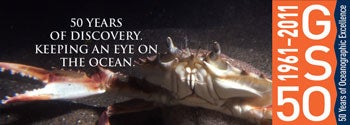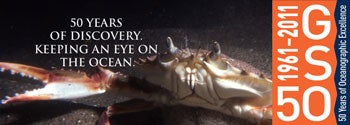 NARRAGANSETT, R.I. – June 8, 2011 – For five decades, the Graduate School of Oceanography at the University of Rhode Island has used Narragansett Bay, the global oceans and the marine environment as a laboratory for research and education. It has built an international reputation as one of the world’s leading oceanographic institutions with a longstanding seagoing tradition.
NARRAGANSETT, R.I. – June 8, 2011 – For five decades, the Graduate School of Oceanography at the University of Rhode Island has used Narragansett Bay, the global oceans and the marine environment as a laboratory for research and education. It has built an international reputation as one of the world’s leading oceanographic institutions with a longstanding seagoing tradition.
As its faculty, staff and students – past and present – prepare to celebrate its 50th anniversary this month, they are reflecting on the significance of GSO to the state of Rhode Island and the global community of scientists, and envisioning future research directions for the coming years.
“The Graduate School of Oceanography is a major player in ocean science and exploration, and it has been since its earliest days,” said GSO Dean David Farmer. “With $25 to $30 million in grant funding every year, the impact of our faculty’s scholarly research and their teaching is felt throughout the oceanographic community and beyond.”
Founded in 1936 as the Narragansett Marine Laboratory by Professors Charles and Marie Fish and reorganized as the Graduate School of Oceanography in 1961, GSO scientists are drawn from across the sub-disciplines of biological, chemical, geological and physical oceanography, as well as from archaeological oceanography and atmospheric chemistry.
LEADING FIGURES
The founding dean, John Knauss, is a giant in the world of marine science, having served on the Stratton Commission, the first review of U.S. ocean policy, in 1969 and having had a hand in the establishment of the URI programs in marine affairs, ocean engineering and resource economics. He brought the first research vessel to URI, the R/V Trident, as well as GSO’s current ship, R/V Endeavor, and he played a key role in creating the National Sea Grant Program, which named a prestigious fellowship after him in 1988.
But he is far from the only influential scientist who has roamed the Bay Campus. Ted Smayda, for instance, is the last remaining GSO scientist still working today who was present when the institution was founded. A leader in the study of phytoplankton, especially those that cause red tides, he started the Narragansett Bay Plankton Time Series in 1959, a weekly measurement of plankton abundance in the Bay that continues today, the longest data set of its kind in the world.
Physical oceanographer H. Thomas Rossby, whose career at GSO dates to the 1970s, is an international leader in the study of ocean currents and circulation, especially the Gulf Stream. He has invented numerous instruments used by physical oceanographers around the world, and he continues to be an innovator in this field.
Jean-Guy Schilling, who retired in 2003, is noted for his use of trace elements and isotopes to understand the composition and dynamics of the Earth’s mantle. He used the volcanic rocks on the seafloor as a window into the deep Earth. He has published more research papers in the prestigious journal Nature than any other URI faculty member.
Hurricane expert Isaac Ginis, estuarine ecologist Scott Nixon, and coastal ecologist Candace Oviatt – the first female graduate of GSO — are others who have been identified as among GSO’s most notable researchers through its history.
SCIENTIFIC BREAKTHROUGHS
Another measure of the significance of the Graduate School of Oceanography can be found in the important scientific discoveries its researchers have made. Among the most important was the 1991 discovery by Professors Haraldur Sigurdsson and Steven D’Hondt of impact glass in Caribbean sediment deposited at the end of the Age of Dinosaurs.
“This was a significant finding because it provided positive evidence that a large impact occurred at the time of the mass extinction. As Haraldur showed, it also provided a clear fingerprint of the suspected impact crater and striking evidence that the impact was unusually damaging,” D’Hondt said. “A number of other people at GSO also greatly advanced understanding of the impact event, with studies by then-graduate students James Zachos and Lowell Stott and Professors Michael Arthur, James Kennett and me showing that the impact had huge effects on the oceans, some of which lasted for millions of years,” he added.
The Narragansett Bay Fish Trawl, which was started by Charles Fish in 1959 and later managed by Professor Perry Jeffries and now Professor Jeremy Collie, is another study that has global implications. The weekly trawl samples the fish community in the Bay and has traced the seasonal and annual changes of marine creatures living there.
“It’s one of the longest continuous studies of marine ecosystems worldwide,” said Collie. “The data are used in high-profile studies of the global syntheses of long-term trends in fish abundance. And they have regional significance, too, as a measure of the pulse of Narragansett Bay.”
Professors Steven D’Hondt, David Smith and Arthur Spivack have made GSO the world leader in the exploration for life deep beneath the seafloor. “The biomass and diversity of life in the seafloor rivals that on land,” said Spivack. “We’ve learned that life can exist with a metabolism 100,000 times lower than anyone thought before. And this research has implications for life on Mars, because the conditions in the deep biosphere are similar to that at the surface of Mars.”
LOCAL CONTRIBUTIONS
The impact of the research conducted by scientists at the Graduate School of Oceanography can perhaps be best seen in its home state of Rhode Island, where Narragansett Bay is considered the state’s most valuable resource and where the Bay plays an important role in the state’s identity. Most of what has been learned about the Bay over the last 50 years, from fish populations and salinity levels to water circulation patterns and nutrient inputs, comes from research initiated at GSO.
“The economic impact of all of that research is immense,” said Professor Chris Kincaid. “The data collected by our researchers is used by the state to manage the Bay. It would cost the state millions every year if it had to collect the data itself, but instead the data is being provided by our faculty and funded mostly by federal grants.”
Kincaid pointed to the Ocean SAMP (Special Area Management Plan) as one recent example. The state effort to zone Rhode Island’s near-shore waters for conservation, recreation and commercial uses, as well as for an offshore wind farm, involved about 25 research projects and more than 30 URI researchers, and most of it was funded by grants from federal agencies.
Equally important is the role that GSO scientists play in responding to and monitoring extreme events in nearby waters like oil spills, fish kills, floods and hurricanes. And the new Inner Space Center, the facility that brings real-time oceanographic research expeditions to Rhode Island – the brainchild of Professor Robert Ballard – is helping to make GSO the hub of global marine exploration.
But GSO is about more than just research. It is one of the largest and most widely known graduate schools of oceanography, with its 800 graduates working in academia, industry, government and environmental organizations around the globe. And its outreach programs play vital roles in providing education and training to key constituencies worldwide. These include the Coastal Resources Center, which contributes coastal management expertise for better governance and stewardship of coastal ecosystems in the U.S. and developing nations from Tanzania to Indonesia; Rhode Island Sea Grant, which works around the region on issues affecting coastal resources and the people who depend on them; and the Office of Marine Programs, which offers educational programming about marine science to a wide variety of audiences, providing a vital link between oceanographers and the general public.
“Our 50th anniversary is also a good time to look forward,” said Farmer. “What will the great oceanographic questions be over the next half-century? How will the technology of oceanographic measurement and analysis change? How will our educational and outreach activities evolve and what will be the pattern of our funding? We can only speculate in response to these questions, but it is important to think carefully of the challenges we face as we chart our path into the future.
“Some things will not change,” he added. “First class ocean research and education will remain the core of a successful Graduate School of Oceanography. The need to conserve marine resources and anticipate the implications of climate change can only intensify the requirement for increased observation and understanding of the ocean and our impact upon it. Living, as we do, on an ocean planet, we know that oceanography has a vital, exciting and important future. We are proud of our past and look forward to another 50 years of exploration, research, education and outreach.”
As part of the 50th anniversary celebration, the Graduate School of Oceanography will host two public events at the Bay Campus. On Saturday, June 25 from 10 a.m. to 4 p.m., visitors can enjoy the Science Saturday Open House, which will provide families with a glimpse into Narragansett Bay and the world’s oceans with free tours of research facilities, exhibits by students and faculty, and hands-on fun. And on Sunday, June 26 from 1 to 5 p.m., local blues legend James Montgomery and his musical friends will perform under a tent on the quadrangle. For more information about these events, visit www.gso.uri.edu/gso_50th.

